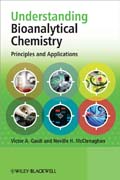
Understanding bioanalytical chemistry: principles and applications
Gault, Victor A.
McClenaghan, Neville H.
Bioanalytical Chemistry for Life and Health Sciences: Principles and Applications is a single core textbook, with supplementary learning materials, which provides a novel teaching and learning resource for tutors and students of first year undergraduate chemistry. The book describes basic principles, terminology, and core technologies, which include modern experimental techniques and equipment used to analyse important biomolecules in diagnostic, industrial, and research laboratory settings. It also provides an introduction to advanced technologies used in the emerging fields of genomics, peptidomics/proteomics, andmetabolomics. INDICE: Contents Preface 1 Introduction to biomolecules 1.1 Overview of chemical and physical attributes of biomolecules 1.2 Classification of biomolecules 1.3 Features and characteristics of major biomolecules 1.4 Structurefunction relationships 1.5 Significance of biomolecules in nature and science 2 Analysis and quantification of biomolecules 2.1 Importance of accurate determination of biomolecules 2.2 Major methods to detect and quantify biomolecules 2.3 Understanding mass, weight, volume and density 2.4 Understanding moles and molarity 2.5 Understanding solubility and dilutions 3 Transition metals in health and disease 3.1 Structure and characteristics of key transition metals 3.2 Importance of transition metals in physiological processes 3.3 Transition metals as mediators of disease processes 3.4 Therapeutic implications of transition metals 3.5 Determination of transition metals in nature 4 Ions, electrodes and biosensors 4.1 Impact of ions and oxidationreduction reactions on physical andlife processes 4.2 pH, biochemical buffers and physiological regulation 4.3 Chemical and physical sensors and biosensors 4.4 Important measurements using specific electrodes 4.5 Specific applications of biosensors in life and health sciences 5 Applications of spectroscopy 5.1 An introduction to spectroscopic techniques 5.2 Major types of spectroscopy 5.3 Principles and applications of ultraviolet/visible spectrophotometry 5.4 Principles and applications of infrared spectroscopy 5.5 Principles and applications of fluorescence spectrofluorimetry 6 Centrifugation and separation 6.1 Importance of separation methods to isolate biomolecules 6.2 Basic principles underlying centrifugation 6.3 Features and components of major types of centrifuge 6.4 Major centrifugation methodsfor bioanalysis 6.5 Flow cytometry: principles and applications of this core method of separation 7 Chromatography of biomolecules 7.1 Chromatography: a key method for separation and identification of biomolecules 7.2 Principles, types and modes of chromatography 7.3 Applications of chromatography in life and health sciences 7.4 High-performance liquid chromatography and advanced separation technologies 7.5 Additional state-of-the-art chromatography techniques 8 Principles and applications of electrophoresis 8.1 Principles and theory of electrophoretic separation 8.2 Major types of electrophoresis 8.3 Electrophoresis in practice 8.4 Applications of electrophoresis in life and health sciences 8.5 Advanced electrophoretic separation methodologies for genomics and proteomics 9 Applications of mass spectrometry 9.1 Major types of mass spectrometry 9.2 Understanding the core principles of mass spectrometry 9.3 Major types of mass spectrometry in practice 9.4 Mass spectrometry: a key tool for bioanalysisin life and health sciences 9.5 Mass spectrometry: future perspectives 10 Immunochemical techniques and biological tracers 10.1 Antibodies: the keys to immunochemical measurements 10.2 Analytical applications of biological tracers 10.3 Principles and applications of radioimmunoassay (RIA) 10.4 Principles and applications of enzyme-linked immunosorbent assay (ELISA) 10.5 Immunohistochemistry: an important diagnostic tool 11 Bioanalysis by magnetic resonance technologies: NMR and MRI 11.1 Nuclear magnetic resonance (NMR) and magnetic resonance imaging (MRI) technologies: key tools for the life and health sciences 11.2Principles of NMR and the importance of this biomolecular analytical technique 11.3 Established and emerging applications of NMR 11.4 Principles and uses of MRI 11.5 MRI as a principal diagnostic and research tool 12 Bioanalytical approaches from diagnostic, research and pharmaceutical perspectives 12.1 Clinical genomics, proteomics and metabolomics 12.2 Clinical diagnosis and screening12.3 Research and development 12.4 Emerging pharmaceutical products 12.5 Future perspectives 13 Self-Assessment Appendix 1: International system of units (SI) and common prefixes Appendix 2: The periodic table of the elements Appendix 3: Common solvents and biological buffers Appendix 4: Answers to self-assessment questions Index
- ISBN: 978-0-470-02907-7
- Editorial: John Wiley & Sons
- Encuadernacion: Rústica
- Páginas: 290
- Fecha Publicación: 23/01/2009
- Nº Volúmenes: 1
- Idioma: Inglés
